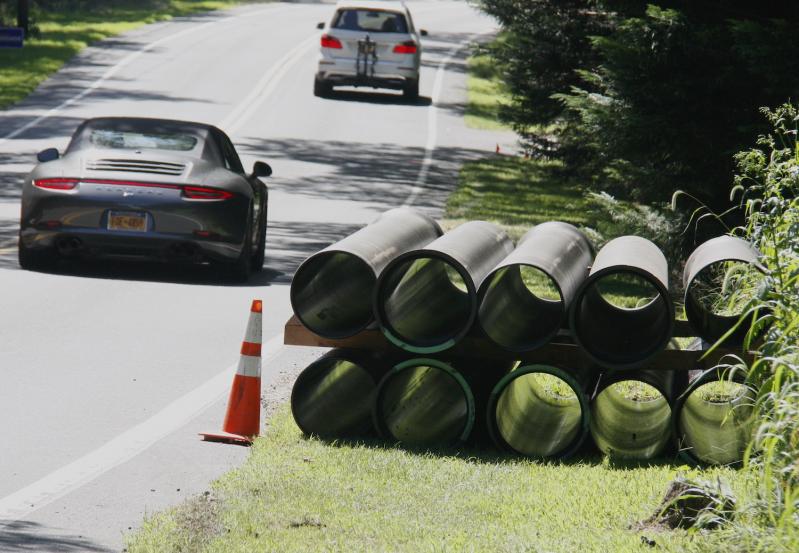Feds Formally Limit ‘Forever Chemicals’
Feds Formally Limit ‘Forever Chemicals’ East Hampton Star


New Water Regulations: Stricter than New York State’s

Introduction
On April 10, the federal Environmental Protection Agency (EPA) issued a final determination on limits for “forever chemicals” in drinking water sources. This determination includes a three-to-five-year timeline for testing and remediation, as well as approximately $1 billion in funding to support states, cities, and other municipalities in carrying out these activities.
Forever Chemicals and their Impact
Forever chemicals, such as perfluoroalkyl and polyfluoroalkyl substances (PFAS), pose a threat to humans and wildlife. These chemicals enter drinking water sources through materials like firefighting foam and manufacturing chemicals, and are difficult to remove once present. The EPA’s new regulations set maximum contaminant levels for six forms of PFAS in drinking water, ranging from 1 to 10 parts per trillion. For PFOA and PFOS, which were previously detected in private water wells in Wainscott above acceptable levels, the limit is set at 4 parts per trillion.
Sustainable Development Goals
- Goal 6: Clean Water and Sanitation
- Goal 14: Life Below Water
- Goal 15: Life on Land
Government Action and Commitment
Brenda Mallory, chairwoman of the White House Council on Environmental Quality, stated that President Biden is committed to providing clean and safe drinking water for all. The establishment of national drinking water standards for PFAS is a significant step towards achieving environmental justice, protecting communities, and securing clean water across the country.
New York State Regulations
New York implemented its own regulations on PFAS in 2020, which set the limit for PFOA and PFOS in drinking water at 10 parts per trillion. However, the EPA’s final ruling is slightly stricter than the state’s regulations.
Support and Compliance
The Suffolk County Water Authority expressed support for the EPA’s critical step in protecting public health. They have been preparing to meet all regulatory requirements within the specified timeframe and assure their customers that their tap water is treated for PFAS when detected.
Timeline and Remediation
The EPA has established a three-year timeline for water utilities and municipalities to implement water quality monitoring and inform their customers of the results. If forever chemicals are detected, a five-year period is provided to implement remediation solutions.
Expert Opinion
Jaymie Meliker, a professor of public health at Stony Brook University, explained that the EPA’s ruling is based on current testing technology. He emphasized that while it is impossible to achieve zero detection, the guidelines for PFAS concentrations are extremely low. Meliker also raised concerns about addressing the root causes of these chemical contaminations and the need for greater transparency in chemical safety testing prior to their release.
Conclusion
The EPA’s new regulations on “forever chemicals” in drinking water demonstrate progress towards achieving the Sustainable Development Goals related to clean water and sanitation, life below water, and life on land. While these regulations are a step in the right direction, there is a need for further discussions and actions to prevent such contamination in the future.
SDGs, Targets, and Indicators
| SDGs | Targets | Indicators |
|---|---|---|
| SDG 6: Clean Water and Sanitation | 6.1 By 2030, achieve universal and equitable access to safe and affordable drinking water for all | – Maximum contaminant levels for PFAS in drinking water – Implementation of water quality monitoring and reporting |
| SDG 3: Good Health and Well-being | 3.9 By 2030, substantially reduce the number of deaths and illnesses from hazardous chemicals and air, water, and soil pollution and contamination | – Reduction in the presence of harmful chemicals in drinking water – Remediation solutions for contaminated water sources |
| SDG 12: Responsible Consumption and Production | 12.4 By 2020, achieve the environmentally sound management of chemicals and all wastes throughout their life cycle, in accordance with agreed international frameworks, and significantly reduce their release to air, water, and soil in order to minimize their adverse impacts on human health and the environment | – Discussion on the need for industry to test chemicals for safety prior to release – Public awareness of the safety testing process for chemicals |
1. Which SDGs are addressed or connected to the issues highlighted in the article?
SDG 6: Clean Water and Sanitation
The article discusses the federal Environmental Protection Agency’s determination on limits for “forever chemicals” in drinking water sources, specifically perfluoroalkyl and polyfluoroalkyl substances (PFAS). These chemicals are harmful to humans and wildlife and can contaminate drinking water sources. The article highlights the efforts to establish maximum contaminant levels for PFAS in drinking water and the importance of access to clean and safe drinking water.
SDG 3: Good Health and Well-being
The presence of harmful chemicals in drinking water, such as PFAS, can lead to adverse health effects. The article mentions the need to reduce deaths and illnesses from hazardous chemicals and pollution. It also discusses the difficulty in removing PFAS from drinking water sources, highlighting the importance of addressing contamination to protect human health.
SDG 12: Responsible Consumption and Production
The article raises questions about the safety testing process for chemicals and the need for industry to test their chemicals for safety prior to release. It emphasizes the importance of managing chemicals and minimizing their adverse impacts on human health and the environment. Public awareness of the safety testing process is also mentioned as a crucial aspect of responsible consumption and production.
2. What specific targets under those SDGs can be identified based on the article’s content?
Under SDG 6: Clean Water and Sanitation:
– Target 6.1: By 2030, achieve universal and equitable access to safe and affordable drinking water for all.
Under SDG 3: Good Health and Well-being:
– Target 3.9: By 2030, substantially reduce the number of deaths and illnesses from hazardous chemicals and air, water, and soil pollution and contamination.
Under SDG 12: Responsible Consumption and Production:
– Target 12.4: By 2020, achieve the environmentally sound management of chemicals and all wastes throughout their life cycle, in accordance with agreed international frameworks, and significantly reduce their release to air, water, and soil in order to minimize their adverse impacts on human health and the environment.
3. Are there any indicators mentioned or implied in the article that can be used to measure progress towards the identified targets?
The article provides indicators that can be used to measure progress towards the identified targets:
– Maximum contaminant levels for PFAS in drinking water: The establishment of maximum contaminant levels for PFAS in drinking water is an indicator of progress towards ensuring safe and affordable drinking water for all (SDG 6, Target 6.1).
– Implementation of water quality monitoring and reporting: The article mentions the three-year timeline for water utilities and municipalities to implement water quality monitoring and inform their customers of the results. This indicates progress towards monitoring and reducing the presence of hazardous chemicals in drinking water (SDG 6, Target 6.1).
– Reduction in the presence of harmful chemicals in drinking water: The article discusses the need to reduce deaths and illnesses from hazardous chemicals, including PFAS, in drinking water. A reduction in the presence of these chemicals would indicate progress towards improving health and well-being (SDG 3, Target 3.9).
– Remediation solutions for contaminated water sources: The article mentions a five-year period for implementing solutions for remediation if forever chemicals are detected in testing. The development and implementation of remediation solutions would indicate progress towards addressing contamination and protecting human health (SDG 3, Target 3.9).
– Discussion on the need for industry to test chemicals for safety prior to release: The article raises questions about the safety testing process for chemicals and highlights the importance of responsible consumption and production. Public awareness of the safety testing process is an indicator of progress towards responsible management of chemicals (SDG 12, Target 12.4).
4. SDGs, Targets, and Indicators
| SDGs | Targets | Indicators |
|---|---|---|
| SDG 6: Clean Water and Sanitation | 6.1 By 2030, achieve universal and equitable access to safe and affordable drinking water for all | – Maximum contaminant levels for PFAS in drinking water – Implementation of water quality monitoring and reporting |
| SDG 3: Good Health and Well-being | 3.9 By 2030, substantially reduce the number of deaths and illnesses from hazardous chemicals and air, water, and soil pollution and contamination | – Reduction in the presence of harmful chemicals in drinking water – Remediation solutions for contaminated water sources |
| SDG 12: Responsible Consumption and Production | 12.4 By 2020, achieve the environmentally sound management of chemicals and all wastes throughout their life cycle, in accordance with agreed international frameworks, and significantly reduce their release to air, water, and soil in order to minimize their adverse impacts on human health and the environment | – Discussion on the need for industry to test chemicals for safety prior to release – Public awareness of the safety testing process for chemicals |
Behold! This splendid article springs forth from the wellspring of knowledge, shaped by a wondrous proprietary AI technology that delved into a vast ocean of data, illuminating the path towards the Sustainable Development Goals. Remember that all rights are reserved by SDG Investors LLC, empowering us to champion progress together.
Source: easthamptonstar.com

Join us, as fellow seekers of change, on a transformative journey at https://sdgtalks.ai/welcome, where you can become a member and actively contribute to shaping a brighter future.







